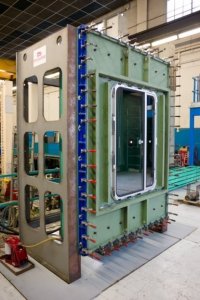Eurailtest and the AEF are Called on to Test the Future TGV-M
Popularly referred to as the TGV of the future, TGV 2020 and now TGV-M, the Avelia Horizon built by Alstom, is the fifth generation of high-speed trains.
This new train, a flexible and modular concentration of innovation designed to meet the new challenges of mobility, is scheduled to enter into service in 2024.
Eurailtest and its partner, the AEF, have been asked to provide their skills and expertise in glazing qualification testing to measure the resistance of the TGV-M’s windows to aerodynamic forces and identify cracked glass and sealing defects that might disrupt the circulation and maintenance of the trains.
Measurement of Pressure Resistance
A company specialized in designing and distributing equipment and solutions for the construction and mobility markets has called on Eurailtest and its partner laboratory, the Railway Test Agency, to perform several tests, mostly comprising glazing qualification tests.
With the aid of its test benches, the Railway Test Agency is able to perform a wide range of tests, including those on the various window components.
AEF experts conducted type approval tests on the window glass in compliance with specifications based on French Standard NFF 01-492. The aim of these tests is primarily to measure pressure resistance.
Simulations of pressure changes produced when two trains cross each other in the open air or in tunnels were conducted on all types of glass windows (flat, new and downgraded) over several millions of cycles.
Pressure amplitudes can range from -8000 Pa to +8000 Pa with gradients reaching up to 200 000 Pa/s.

Tests to Check Water Tightness
The AEF then performed further tests to check the water tightness of a window.
Water was sprayed onto the outer surface of the glass tested in downgraded mode, meaning that the inner side of the window complex is downgraded in compliance with a standard format.
The outer side of the glass pane is cracked. Several cycles of positive and negative pressure are then run to analyse how the glass complex behaves in this situation.
Tests on Structural Seal Loosening
To assess the rupture strength of the structural bonded seal, two windows are installed on a special test bench. Pressure up to 60 kPa is gradually applied to the first window.
The test is then performed on a second window that has already undergone a fatigue test. The same method is applied to this second window up to 42 kPa.
This test is performed to check the seal’s behaviour and resistance.
Measurement of Dew Point
This test is performed to check the window’s thermal insulation. Due to the effect of condensation a dew point forms on the inner surface of the glass, which should not appear before reaching -50 °C.
To measure the humidity level, intermittent cooling is applied gradually to the outer surface of the glass down to – 50 °C.
It is important to identify the dew point to prevent any water damage on the window frame from compromising its durability.
The AEF therefore continues to demonstrate its expertise, drawing on its scientific and technical skills, the efficient use of its test benches to perform and deliver testing on demand, and its strength in the form of its committed teams of experts.
Copyright : Eric Pothier/SNCF






 FR
FR